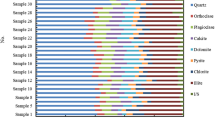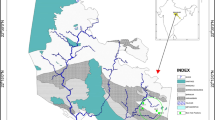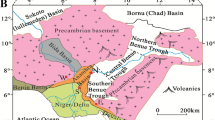Abstract
In this paper, the mineral and pore structure characteristics of Longmaxi shale gas reservoir have been studied with a series of parallel experiments on core samples drilled from Jiaoshiba gas field, southern Sichuan Basin, China, including X-ray diffraction (XRD) tests, total organic carbon (TOC) analysis, field emission scanning electron microscopy (FE-SEM), low temperature nitrogen adsorption/desorption (LTNA), and nuclear magnetic resonance (NMR). The relations among TOC, mineralogical compositions and pore structure parameters, and comparison of pore size distribution (PSD) of shales obtained by LTNA and NMR are discussed. The results show that the Longmaxi shales are rich in organic matter, with an average content of 2.73%. The mineralogical compositions are dominated by quartz and clay minerals, with an average content of 43.72 and 36.32%, respectively. The TOC has strong positive correlations to the quartz and pyrite, but negative correlations to clay mineral. There are three types of pores, including organic pores, inorganic pores (inter-crystalline pores and intergranular pores), and microfractures (diagenetic shrinkage joints and organic evolution abnormal-pressure fracture), which can be seen from FE-SEM, with pore sizes following the order of organic pores <inorganic pores < micro-fractures. The organic matter and quartz have a positive influence on the specific surface (ranging from 7.27 to 14.705 m2/g) and total pore volume (ranging from 0.004 to 0.02 cm3/g), whereas clay minerals have a negative effect on the specific surface and total pore volume. Compared with LTNA, the NMR can better reveal pores, indicating pore size ranging from smaller than 1 nm to several tens of micrometers. The PSDs acquired from NMR present tri-modal distribution when TOC content is higher than 2.5% and clay mineral content lower than 40%. On the contrary, the PSDs present bi-modal distribution when TOC content is lower than 2.5% and clay mineral content higher than 40%.








Similar content being viewed by others
References
Brunauer S, Emmett PH, Teller E (1938) Adsorption of gases in multimolecular layers. J Am Chem Soc 60:309–319
Barrett EP, Joyner LG, Halenda PP (1951) The determination of pore volume and area distributions in porous substances. I Computations from nitrogen isotherms J Am Chem Soc 73(1):373–380
Cao TT, Song ZG, Wang SB et al (2015) Characterizing the pore structure in the Silurian and Permian shales of the Sichuan Basin, China. Mar Pet Geol 61:140–150
Clarkson CR, Solano N, Bustin RM et al (2013) Pore structure characterization of north American shale gas reservoirs using USANS/SANS, gas adsorption, and mercury intrusion. Fuel 103:606–616
Chalmers GRL, Bustin RM, Power IM (2012a) Characterization of gas shale pore systems by porosimetry, pycnometry, surface area, and field emission scanning electron microscopy/transmission electron microscopy image analyses: examples from the Barnett, Woodford, Haynesville, Marcellus, and Doig units. AAPG Bull 96(6):1099–1119
Chalmers GRL, Ross DJK, Bustin RM (2012b) Geological controls on matrix permeability of devonian gas shales in the horn river and liard basins, northeastern British Columbia, Canada. Int J Coal Geology 103:120–131
Guo XS, Li YP, Liu RB, Wang QB (2014) Characteristics and controlling factors of micro-pore structures of Longmaxi shale play in the Jiaoshiba area, Sichuan Basin. Natur Gas Ind 4(6):9–16
Groen JC, Peffer LAA, Perez-Ramírez J (2003) Pore size determination in modified micro- and mesoporous materials. Pitfalls and limitations in gas adsorption data analysis. Microporous Mesoporous Mater 60:1–17
Hu QH, Ewing RP, Rowe HD (2015) Low nanopore connectivity limits gas production in Barnett formation. J Geophy Res – Solid Earth 120(12):8073–8087
Hinai AA, Rezaee R, Esteban L et al (2014) Comparisons of pore size distribution: a case from the western Australian gas shale formations. J Uncon Oil and Gas Res 8:1–13
Liu XJ, Xiong J, Liang LX (2015) Investigation of pore structure and fractal characteristics of organic-rich Yanchang formation shale in Central China by nitrogen adsorption/desorption analysis. J Nat Gas Sci Eng 22:62–72
Li J, Jin WJ, Wang L et al (2016) Quantitative evaluation of organic an inorganic pore size distribution by NMR: a case from the Silurian Longmaxi formation gas shale in Fuling area, Sichuan Basin. Oil Gas Geol 37(1):129–134
Li JJ, Yin JX, Zhang YN et al (2015) A comparison of experimental methods for describing shale pore features—a case study in the Bohai Bay basin of eastern China. Int J Coal Geol 152:39–49
Liang LX, Xiong J, Liu XJ (2015) An investigation of the fractal characteristics of the upper Ordovian Wufeng Formtion shale using nitrogen adsorption analysis. J Nat Gas Sci Eng 27:402–409
Looyestijin W, Hofman J (2006) Wettabilitty index determination by nuclear magnetic resonance. SPE Res Eval & Eng 9(2):146–153
Melnichenko YB, He LL, Sakurovs R et al (2012) Accessibility of pores in coal to methane and carbon dioxide. Fuel 91:200–208
Okolo GN, Everson RC, Neomagus HWJP et al (2015) Comparing the porosity and surface areas of coal as measured by gas adsorption, mercury intrusion and SAXS techniques. Fuel 141:293–304
Ross DJK, Bustin RM (2009) The importance of shale composition and pore structure upon gas storage potential of shale gas reservoirs. Mar Pet Geol 26:916–927
Saidian M, Prasad M (2015) Effect of mineralogy on nuclear magnetic resonance surface relaxivity: a case study of middle Bakken and three forks formations. Fuel 161:197–206
Sing KSW, Everett DH, Haul RAW et al (1985) Reporting physisorption data for gas/solid systems with special reference to the determination of surface area and porosity. Pure Appl Chem 57(4):603–619
Sigal RF, Odusina E (2011) Laboratory NMR measurements on methane saturated Barnett shale samples. Petrophysics 52(1):32–49
Tinni A, Odusina E, Sulucarnain I et al (2015) Nuclear magnetic resonanse of brine, oil, and methane in organic-rich shales. SPE Reservoir Evaluation & Engineering August:400–406
Tian H, Pan L, Xiao X et al (2013) A preliminary study on the pore characterization of lower Silurian black shales in the Chuandong thrust fold belt, southwestern China using low pressure N2 adsorption and FE-SEM methods. Mar Pet Geol 48:8–19
U. S. Energy Information Administration (EIA) (2013) Technically recoverable shale oil and shale gas resources: an assessment of 137 shale formation in 41 countries outside the united sates. http://www.eia.gov/analysis/studies/worldshalegas.
Wei XF, Liu RB, Zhang TS et al (2013) Micro-pores structure characteristics and development control factors of shale gas reservoir: a case of Longmaxi formation in XX area of southern Sichuan and northern Guizhou. Petrol Geosci 24(5):1048–1059
Xiong J, Liu XJ, Liang LX (2015) Experimental study on the pore structure characteristics of the upper Ordovician Wufeng formation shale in the southwest portion of the Sichuan Basin, China. J Nat Gas Sci Eng 22:530–539
Yao YB, Liu DM, Che Y et al (2009) Non-destructive characterization of coal samples from China using microfocus X-ray computed tomography. Int J Coal Geol 80:113–123
Yao YB, Liu DM, Che Y et al (2010) Petrophysical characterization of coals by low-field nuclear magnetic resonance (NMR). Fuel 89:1371–1380
Yang F, Ning ZF, Liu HQ (2014) Fractal characteristics of shales from a shale gas reservoir in the Sichuan Basin, China. Fuel 115:378–384
Zhao PQ, Mao ZQ, Huang ZH et al (2016) A new method for estimating total organic carbon content from well logs. AAPG Bulltin 100(8):1311–1327
Acknowledgements
This research was supported jointly by the National Natural Science Foundation of China (Grant No. 41504108), Young Scholars Development Fund of SWPU (Grant No. 201499010020), Fund Project of Sichuan Provincial Education Department (Grant No. 15ZB0057), Open Fund Project of Key Laboratory of Sedimentary Basin and Oil and Gas Resources, Ministry of Land and Resources (Grant No. ZDSYS2015003), Fund Project of China Postdoctoral Science Foundation (Grant No. 2015M582568), and Chongqing Land Bureau Science and Technology Planning Project (Grant No. CQGT-KJ-2014017).
Author information
Authors and Affiliations
Corresponding author
Rights and permissions
About this article
Cite this article
Wang, L., Fu, Y., Li, J. et al. Mineral and pore structure characteristics of gas shale in Longmaxi formation: a case study of Jiaoshiba gas field in the southern Sichuan Basin, China. Arab J Geosci 9, 733 (2016). https://doi.org/10.1007/s12517-016-2763-5
Received:
Accepted:
Published:
DOI: https://doi.org/10.1007/s12517-016-2763-5




